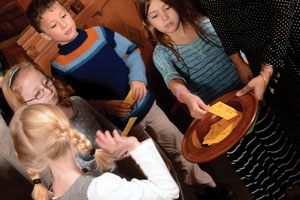Lessons for life: teaching kids about money
By tailoring financial messages to the age of a child, parents can encourage generous giving and responsible saving.
by Becky D’Angelo-Veitch

I stood open-mouthed, looking at the envelope. There on the kitchen counter sat my parents’ pledge, ready for church the next morning. As a 13-year-old, I hadn’t really thought about those little envelopes tucked in my dad’s jacket pocket each Sunday. Although I knew my parents gave money to the church, I hadn’t bothered to wonder how much. Then I saw it, on that little line after the dollar sign: a figure that was larger than any sum I’d ever been given for a day at the mall. “You give that much to the church?” I said with all the righteous indignation of a teen denied the most recent fashion craze. Although I don’t remember exactly what my mother said in reply, I can remember the message: It’s not all about you.
In a different house in a different town in that same era, my future in-laws diligently saved exactly twice the cost of a new color TV. My husband, Robert, remembers this because his parents believed in making a charitable donation equal to the cost of each big purchase, including that TV.
These moments from our childhood have stayed with us. Robert and I are humbled, grateful, and challenged by the examples that our parents set for us. Now parents ourselves, we strive to set examples for our children and give them the tools to be both responsible savers and generous givers. It’s a fine line to walk every day, and, like so many others, we struggle with trying to always make the right choice.
We aren’t alone. In an era when parents worry not only about saving enough in 529 college accounts but also about giving their children too much, many people wonder, How do we talk about money with our children? As Presbyterians, we ask ourselves, How do we model our values and our call to be faithful stewards in a tech-driven world where our children rarely see cash at the grocery checkout, much less in an offering plate?
These questions don’t have black-and-white answers, but experts in financial stewardship and educational ministries offer advice—and hope. Candace Hill, coordinator of educational ministries for the Presbyterian Mission Agency, says parents can help their children develop a spirit of generosity as well as financial responsibility by “showing them with their own actions, decisions, and priorities.”
Developing ‘money sense’
Hill and other experts suggest tailoring the approach to the age of the child. This can begin as soon as a child can count, Hill says. Simple lessons such as teaching the value of different coins give young children the foundation for developing “money sense.” Experts say this kind of early education is increasingly valuable in a society where children might otherwise lack an understanding of money because of our growing reliance on plastic cards and electronic transfers to conduct our transactions.
As early as preschool, children can take their money to a store for planned purchases—with planned being the key. In our family, for instance, an early and meaningful stewardship lesson involved letting our daughter—then about five years old—take some of her money to a store to buy jars of baby food for a food pantry. It was a tangible and affordable way for her to see that her “sharing” money could directly help others in need.
Zeta Lamberson, president of the Association of Presbyterian Church Educators, created a faith-formation curriculum titled Stepping Stones on the Journey of Faith that lays out milestones for different age groups (for more information about this resource, email Lamberson at billzeta@bellsouth.net). For example, she says elementary school students in churches that still collect offerings can understand that their offering is one important way Christians serve God and express thanks to God. Children in this age range can even begin using their own offering envelopes, she says.

Children at Third Presbyterian Church in Rochester, New York, have the option of using their own envelopes for the Sunday school offering.
Ruling elder Sarah Boyce and her husband, Tim Stout, who are members of Third Presbyterian Church in Rochester, New York, have made it a point to communicate their commitment to church to their eight- and nine-year-old daughters. “We do talk about the fact that we give to the church,” Boyce says. “We don’t talk about specific dollars, but we want them to know that we value the church and think it’s important enough that we are willing to give some of our money to help pay for various church expenses, and that some of that money supports important outreach programs.”
Connecting money and ministry
Lamberson suggests talking to children at every step about the practical uses of stewardship dollars. By the age of 10, she says, children should be able to name things that their money supports at church. She also notes that stewardship education for this age group should emphasize not only giving but also involvement in mission and service.
Christian educator Kathryn McGregor recalls a particularly meaningful project at the congregation she serves, Unity Presbyterian Church in Fort Mill, South Carolina. Last spring, second to fifth graders embarked on the Clean Water for All God’s Children project to help raise funds for Living Waters for the World, a ministry of the Synod of Living Waters. Children solicited pledges for their participation in a “Walk for Water” to benefit the ministry, which teaches people how to build and operate systems that provide clean water for communities in developing countries. “It ended up being an opportunity for the children to lead the adults,” McGregor says. “We walked half a mile, then picked up gallon jugs of water and carried them back to our starting point. We had great conversation on the way back about what it would be like to be barefooted, carrying an open jug that might splash out, and having to watch out for dangers along the way. It was a great real-life lesson for our children about something we all take for granted.”
As children get older, parents and church communities can add another layer. For example, Lamberson says, middle schoolers can understand setting aside a specific percentage of their money for church and charitable giving. Participation in mission, both local and “destination,” also are options for the middle school set. This is an age of budding activism—and a perfect time for parents and church communities to demonstrate how they use their time and talents as an expression of their faith.
As children continue to mature, more doors open for ways to serve and give. High school is the time to invite young people to take what they learned as children and begin to engage in the habits that we hope they will maintain as adults, such as regularly giving of their time as they discern how God is calling them to discipleship.
‘It’s cool to see how we all care’
Learn more
Candace Hill, coordinator of educational ministries, is available to answer questions and provide assistance: candace.hill@pcusa.org;
800-728-7228 x5166.
For a creative idea on teaching your children about charity, see Brian Frick’s Presbyterians Today article “A hundred dollars and a hope”: store.pcusa.org (search for the September 2014 issue—or, if you’re a subscriber, simply sign in to your digital account and search the archives).
For youth, consider Faith Questions: Money, a minicourse based on four questions posed by actual youth: (1) Is it OK to pray for more money? (2) What’s so wrong with wanting money? (3) What if I don’t have any money? (4) Are we really supposed to give our money away?: pcusastore.com (search by title).
For further reading: Giving Together: A Stewardship Guide for Families by Carol A. Wehrheim (Westminster John Knox, 2004): pcusastore.com (search by title)
Like many youth, Angelina Violante, a 14-year-old from First Presbyterian Church of Katonah, New York, participates in mission trips and fundraisers. Among her church’s fundraisers is an auction in which the youth offer their services, such as tutoring or yard work, to be bid on. Angelina, whose specialty cakes are a staple of the annual auction, says, “I find the auction meaningful because it’s cool to see how we all care for each other by offering our gifts to the people in the congregation as well as raising money.”
For most young people, an allowance remains their main source of “income.” Although some parents and financial professionals question whether children should get an allowance, 61 percent of parents give one, according to the American Institute of CPAs. For some parents, paying an allowance gives them the opportunity to teach not only about saving but also about being generous.
McGregor and her husband, Sam, pastor of Allison Creek Presbyterian Church in York, South Carolina, decided to pay a monthly allowance to their three children (now in middle school, high school, and college). Initially, they required their children to give 50 cents a week to church and to save a portion. As they got older, their allowance increased, as did their financial responsibilities, such as purchasing gifts for siblings, paying for outings with friends, and fulfilling their own church pledges.
But whether or not children get an allowance, experts agree that the discussions we have about money—as well as the examples we set—can help our children become generous givers and responsible savers.
“We do a disservice when we do not talk about money and generosity and giving and serving,” Hill says. Whether it is an accidental glance at a check or a shared decision about a large purchase that gets us started, we must have those conversations and be open with our children as we share our values, model good stewardship, and invite them to find and follow their passions in giving.
Becky D’Angelo-Veitch is the children’s ministry coordinator at Third Presbyterian Church in Rochester, New York. A certified associate Christian educator in the PC(USA), she holds a certificate in youth and theology from Princeton Theological Seminary.


